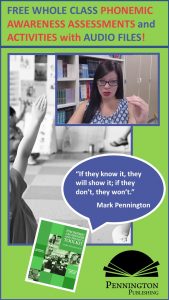Phonemic Awareness Assessments
“There is considerable evidence that the primary difference between good and poor readers lies in the good reader’s phonological processing ability” (University of Oregon Center on Teaching and Learning). We all know the importance of phonemic awareness as both a predictor (Goldstein, 1976; Zifcak, 1977; Stanovich, 1986, 1994) and causal factor (Adams, 1990) in reading readiness. Students need to hear, identify, and manipulate the sounds of the language before (or while) learning to read. Although some researchers still posit the notion that complete phonemic awareness is a by-product of reading, most reading researchers and teachers now see phonemic awareness as a teachable prerequisite to reading (Smith, Simmons, & Kame’enui, 1998).
If phonemic awareness is critically important to reading and it can be taught, we should do so both as pre-school to second grade beginning reading instruction and as third grade to adult reading remediation.
Some encouraging research indicates that remedial readers can learn phonemic awareness with the right teaching strategies. Bhat, Griffin, and Sindelar (2003) reported that middle school remedial readers do benefit from phonemic awareness training, although, unfortunately, not as much as do younger learners.
Additionally, although specific speech sounds (phonemes) do differ among languages, making phonemic awareness and phonics acquisition more challenging for English-language Learners (ELs), these students are certainly able to transfer their phonemic awareness skills from their primary languages to English, and research supports the benefits of phonemic awareness training for second language learners (Abbot, Quiroga, Lernos-Britton, Mostafapour, and Berninger, 2002). In fact, some primary languages, such as Spanish, share more phonemes with English than not.
Moreover, because phonemic awareness is an auditory skill, speech therapists will emphasize the importance of teaching and practicing phoneme manipulation to special education students, many of whom are diagnosed with auditory learning challenges.
So how should we teach phonemic awareness to beginning, remedial, EL/ELD, and special education students? Assessment-based instruction.
1. Efficient, comprehensive, and accurate whole class (or at least small group) phonemic awareness assessments to determine what beginning and remedial readers know and don’t know. With these tests, teachers can feel confident that “if they know it, they will show it; if they don’t, they won’t.” Not all students will have mastered the same components of phonemic awareness. No more time-consuming individual phonemic awareness assessments? Yeah! Download the six assessments below for free.
2. Assessment-based phonemic awareness activities designed to teach the phonemic awareness deficits indicated by the assessments. Why teach the same phonemic awareness activity whole class to, say a kindergarten or an intermediate or middle school reading intervention class, when not all students need to remediate the same phonemic awareness skill? Instead, use the assessment-data to determine instructional decisions. Perfect for whole class (if the assessments so indicate the need), small ability groups (think learning stations and cooperative groups), and individualized instruction. Download the sample phonemic awareness activities below for free.
Phonemic Awareness Assessments
Here are the six phonemic awareness assessments. By the way, reading specialists suggest remediating these skills in the order listed here:
- Rhyming Awareness
- Alphabetic Awareness (Make sure to check out the Mp3 “New Alphabet Song” found in the phonemic awareness activities packet.)
- Syllable Awareness and Syllable Manipulation
- Phonemic Isolation
- Phonemic Blending
- Phonemic Segmentation
Each of the assessments has a teacher and student page (for recording… remember that phonemic awareness is an auditory skill).
Get the Phonemic Awareness Assessments FREE Resource:
![]()
Plus, five of the six (not the alphabetic awareness assessment) include audio files. Woohoo!
Phonemic Awareness Audio Files
Syllable Awareness Assessment (5:48)
Syllable Rhyming Assessment (5:38)
Phonemic Isolation Assessment (5:54)
Phonemic Blending Assessment (5:53)
Phonemic Segmenting Assessment (5:21)
Phonemic Segmenting Assessment
Reading Assessment Matrix
You’ll love this one-page assessment matrix for student data and simple progress monitoring: Reading Assessments Recording Matrix
But what about the resources to teach what the phonemic awareness assessments indicate to be unmastered skills? Got you covered! Check out some of the phonemic awareness activities used in the author’s reading intervention program linked at the end of this related article.
Each of the above resources is included for teachers to review components of my two reading intervention programs. Click on the provided links to view video overviews and to download sample lessons.

The Teaching Reading Strategies (Intervention Program) is designed for non-readers or below grade level readers ages eight–adult. This full-year, 55 minutes per day program provides both word recognition and language comprehension instructional resources (Google slides and print). Affordable and evidence-based, the program features the 54 Sam and Friends Phonics Books–decodables for each lesson and designed for older students. The digital and print word recognition activities and decodables are also available as a half-year (or 30 minutes per day) option in The Science of Reading Intervention Program. Both programs include the easy-to-teach, interactive 5 Daily Google Slide Activities.
PREVIEW TEACHING READING STRATEGIES and THE SCIENCE OF READING INTERVENTION PROGRAM RESOURCES HERE.

